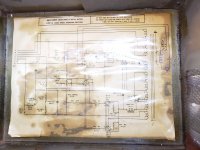I'm servicing a US military surplus tube-regulated power supply and ran across this schematic symbol (47) which I have never seen before.

It looks like a big, fat glass cylinder (in between the tubes and the fuses) - can anyone identify it?

TYVM,
It looks like a big, fat glass cylinder (in between the tubes and the fuses) - can anyone identify it?
TYVM,
Attachments
Could that be a gas filled spark gap? What is the winding voltage and any idea what it was connected to in the original application?
If that thing that looks like a giant fuse really was a high voltage fuse it would surely just arc across to the normal fuses next to it.
I am now curious about what the big fuse thing is.
I am now curious about what the big fuse thing is.
Gotta love mil-surp. Too bad it's mostly dried up. Gives you new perspectives from half a century ago.
All good fortune,
Chris
All good fortune,
Chris
Yes.
Voltage across its terminals will tell us A LOT, not sure why it was not shown on the very first post .
#47 is an old and VERY popular 6.3V lamp bulb, this might be the same but "hidden in plain ight" inside a lamp holder, or the "big glass bulb" could be a special clip-on version; regular #47 uses a bayonet base.

The symbol may very well be that of a filament lamp, drawn slightly different from the conventional one.
Voltage across its terminals will tell us A LOT, not sure why it was not shown on the very first post .
#47 is an old and VERY popular 6.3V lamp bulb, this might be the same but "hidden in plain ight" inside a lamp holder, or the "big glass bulb" could be a special clip-on version; regular #47 uses a bayonet base.

The symbol may very well be that of a filament lamp, drawn slightly different from the conventional one.
ejp is probably right, and the big cylinder is a hand-wound precision resistor to trim the voltmeter's reading. This would have been important for a power supply, and for military reliability, and cost no object, could have been considered more reliable than a pot. If true, then the glassy look is just a shiny paper covering. Inquiring minds....
All good fortune,
Chris
All good fortune,
Chris
Or a foil shield, for whatever reason?
Using a filament lamp in an item subject to vibration, would be less than military grade reliable.
They would have to manage with the best they could get...
Using a filament lamp in an item subject to vibration, would be less than military grade reliable.
They would have to manage with the best they could get...
Theere was nothing else available, unless you had >100V and could use a neon bulb.Using a filament lamp in an item subject to vibration, would be less than military grade reliable.
But this one is clearly across a winding.
To boot, schematic talks about supplying 6.3V, 12.6V and 28V, all AC presumably filament windings and itb shows 3 windings in series; with "47" across one of them, so .... not much doubt about it left.
I did say:
'They would have to manage with the best they could get...'
Military builds have their own oddities and constraints.
Here we had some strict inspection for military equipment, and reject stuff was reputedly sold in the civilian market.
Royal Enfield bikes were notoriously poor, people used to get old bikes from military auctions and rebuild them.
Bad castings, leaky heads, gear failures, bent front forks, leaking fuel hoses...all were common in new Enfield bikes purchased from the dealer.
And of course old trucks and jeeps were rebuilt...long story.
In conclusion, the glass cylinder is a bulb in safety enclosure?
Or a fuse with the terminals on the same side?
'They would have to manage with the best they could get...'
Military builds have their own oddities and constraints.
Here we had some strict inspection for military equipment, and reject stuff was reputedly sold in the civilian market.
Royal Enfield bikes were notoriously poor, people used to get old bikes from military auctions and rebuild them.
Bad castings, leaky heads, gear failures, bent front forks, leaking fuel hoses...all were common in new Enfield bikes purchased from the dealer.
And of course old trucks and jeeps were rebuilt...long story.
In conclusion, the glass cylinder is a bulb in safety enclosure?
Or a fuse with the terminals on the same side?
- Home
- Amplifiers
- Tubes / Valves
- Unknown schematic symbol
